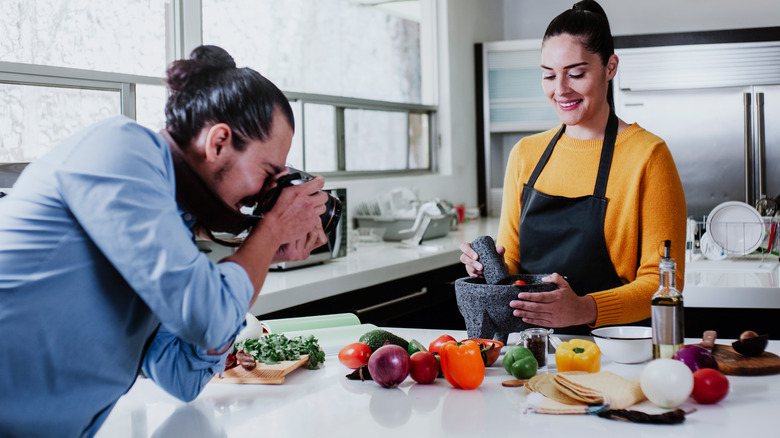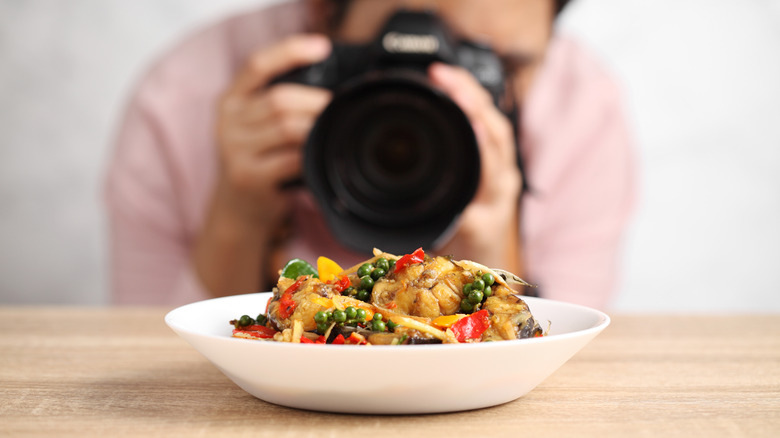How Much Do Food Stylists Typically Make?
According to The New York Times Style Magazine, it became popular around the mid-nineteenth century to take pictures of food rather than just pictures of people that happened to include food, thus inaugurating the beginning of food styling, which was then and still remains closely tied to photography. Photographs from that era often resemble still-life paintings, with such images as black and white pictures of assortments of fruits carefully arranged in woven baskets on picnic tables.
Over the years, demand for food stylists has increased in tandem with the commodification and commercialization of food. For example, Gourmet magazine debuted in 1941, introducing readers to slick, upscale, and beautifully styled photographs (via The New York Times). Encyclopedia.com writes food stylists typically begin an assignment by meeting with the client, photographer or director/videographer, and prop stylists to review recipes, layouts, storyboards, food, equipment, and other materials that must be procured for the shoot.
Then, food stylists are responsible for picking out food and "stand-in" items that allow the photographer or director time to stage the shoot and perfect the lighting. As food generally loses its luster over time, the stand-in items are replaced with "hero" food for the final shoot, whose fresh appearance stylists are tasked with maintaining with techniques including, perhaps most commonly, adding moisture by brushing the food with water or vegetable oil.
Different types of food styling jobs
Despite the very broad range of work in which food stylists are engaged, from working with cookbook authors and publishers to assisting fast food companies and grocery stores with advertising campaigns, until the late 1900s very few courses were available at culinary schools. (via Encyclopedia.com). Chron.com notes that food styling does not require a specific degree, but most people who get into this line of work have formal training or degrees in culinary arts. Additionally, people interested in pursuing this career path often choose to apprentice under experienced stylists or attend seminars and classes.
According to The Globe and Mail, food marketers and companies engaged in the business of selling food have sought out food stylists with experience working on projects for social media platforms — work for which they are often well-compensated. Salary.com writes there is a broad range of compensation for food stylists, depending on candidates' experience, education, certifications, and additional skills. The site includes links to five recent openings for job applications, all of which are based in New York City. Likewise, the overwhelming majority of openings posted on Indeed are based in New York, with Las Vegas a distant second. So, how much do food stylists generally make?
Experienced freelance food stylists can command higher salaries than you might expect
According to Chron, many food stylists are hired to work on freelance contracts, but some companies hire professionals to work in-house on a full-time basis. Citing data from Simply Hired, Chron indicates the average annual salary for food stylists is $33,000. However, established food stylists can command freelance rates as high as $450 to $850 per day. Their maximum potential yearly salaries, working 40 hours per week and 52 weeks per year, would therefore range between roughly $117,000 and $221,000. Perhaps unsurprisingly, compensation for food stylists who work in New York and San Francisco tends to be substantially greater than pay in cities like Orlando or Savannah.
Roughly in line with the higher estimates published by Chron, Comparably indicates the average salary for food stylists in the US is $140,635. The mean annual compensation in San Francisco is $210,649, which is 50% greater than the national average, according to the site. The highest-paid food stylists in the country can expect to make as much as $730,998. The median annual salary for food stylists calculated by Comparably, $130,885, is relatively close to the site's estimated national average, while the middle 57% of earners pull in between $130,885 and $330,576 per year.
What should you know before starting a career as a food stylist?
Comparably reports on varying compensation for food stylists in most American cities, with some areas like Washington, D.C. and San Francisco offering above the national average. Other cities like Austin and Denver also have higher pay, which reinforces the geographically based variability in demand and compensation for food stylists. While established food stylists are often handsomely paid, and many enjoy working from home with a flexible schedule, working on a contract or freelance basis can be challenging. These jobs do not offer benefits, and workloads can vary substantially week to week (via The Balance Careers).
There are also some potential drawbacks associated with food styling in particular, whether working on a freelance basis or full-time in-house. According to AdvertisingRow, the work is structured around inflexible deadlines that may require frequent retakes, reshoots, and last-minute changes. AThe field can be competitive to break into without a bit of work and making connections. Speaking to Media Bistro, food stylist Tami Hardeman, who has worked on national advertising campaigns for brands including McDonald's and Olive Garden, outlined some advice for breaking into the business.
"Styling food is not easy," Hardeman said, and the best way to learn is not necessarily through taking classes but rather through practice. "Take time with your camera — it doesn't have to be a fancy camera — and take photographs of your food or have someone take photographs of your food."



